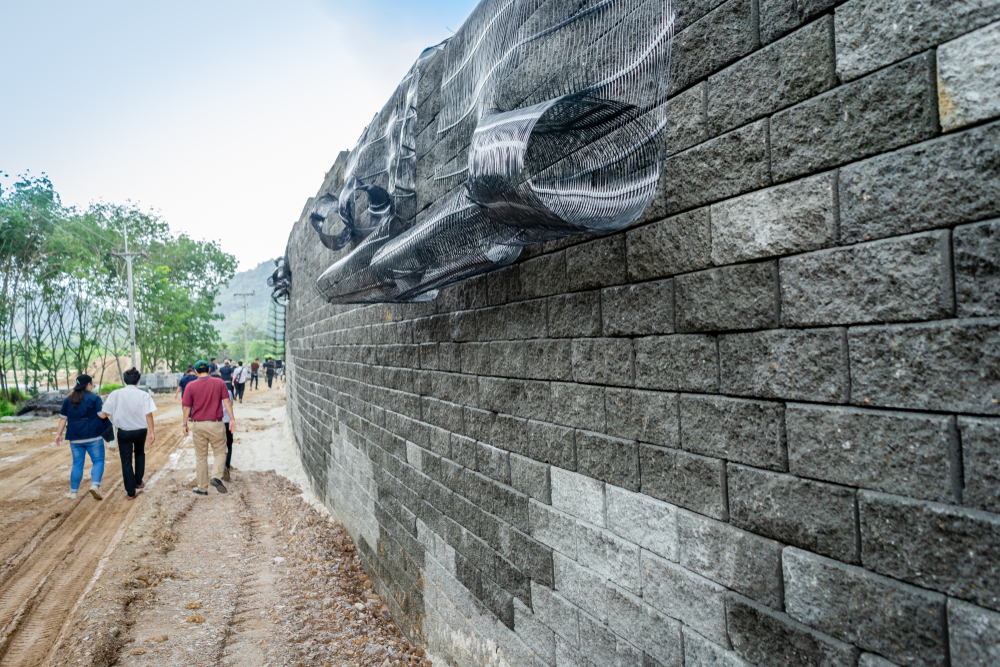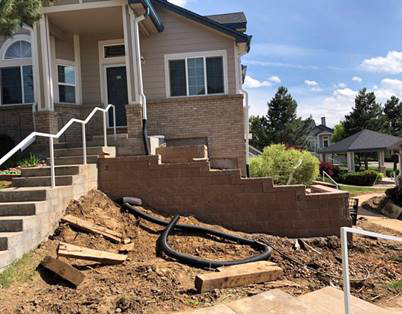Maintenance strategies to keep OKC Precision Retaining Walls standing strong for decades
The Essential Guide to Understanding the Performance of Retaining Walls
When it pertains to taking care of sloped landscapes, retaining walls are necessary. They not only keep back soil but additionally avoid erosion and secure your building from prospective landslides. Comprehending their performance can help you make notified choices about style and maintenance. Yet what types of retaining walls are offered, and how do you choose the best products? Allow's discover these vital considerations additionally.
What Are Retaining Walls and Their Function?
Retaining walls are essential frameworks designed to hold back soil and prevent erosion, especially on sloped landscapes. When you assume concerning a retaining wall surface, consider its duty in managing water overflow, which can erode soil over time.
In addition, retaining walls can produce useful rooms in your lawn. By leveling out a sloped location, you can acquire a lot more functional exterior space for horticulture, patio areas, or play locations. The design and products you choose can boost your residential property's looks, making it visually appealing.
Inevitably, comprehending the function of retaining walls assists you value their significance in landscape monitoring (OKC Precision Retaining Walls). They not only shield your residential or commercial property however additionally contribute to the total charm and functionality of your outside room
Types of Retaining Walls: An Introduction
When it comes to taking care of dirt and water drainage in your landscape, understanding the various kinds of retaining walls can assist you make an educated option for your property. Gravity walls rely on their weight to hold back soil, making them a strong alternative for smaller sized slopes. Cantilever walls, on the various other hand, make use of a lever-like design, which allows them to support a lot more substantial loads with much less material.
Secret Materials Used in Retaining Wall Building
To produce a durable and effective retaining wall surface, selecting the best products is crucial. You'll discover that concrete is a prominent choice as a result of its longevity and stamina. Precast concrete blocks offer versatility in design, while put concrete supplies a seamless appearance. If you prefer an even more natural appearance, rock or block can add visual charm and blend with the landscape.
Wood is another alternative, especially for smaller walls, yet keep in mind it might not last as long as a result of degeneration. Steel and gabion walls, which utilize cable mesh loaded with rocks, are likewise reliable for certain circumstances. Each product has its own benefits and downsides, so consider your wall surface's purpose, area, and budget. Ultimately, the right material will improve the wall's security and long life, ensuring it satisfies your requirements while standing the examination of time.

Layout Considerations for Effective Retaining Walls
Designing an effective retaining wall includes careful consideration of several essential factors, as the wall needs to stand up to both vertical and lateral forces. First, evaluate the soil type and its homes; cohesive dirts behave differently than granular ones. You'll likewise desire to figure out the elevation of the wall surface, as taller walls require more robust style services.
Next, think about drain. Correct water drainage stops water buildup behind the wall, decreasing pressure and potential failure. Incorporate weep holes or water drainage pipelines for efficient water management.
Likewise, believe concerning the materials you'll utilize. Various materials, like concrete, rock, or lumber, deal differing strengths and visual appeals.
Finally, do not forget neighborhood regulations and codes. They frequently dictate layout criteria and building and construction methods. By resolving these considerations, you can assure your retaining wall is not only useful yet also long lasting and safe.
Applications of Retaining Walls in Landscape Design and Building And Construction
Retaining walls serve an essential duty in both landscaping and building and construction, as they help manage changes in elevation and protect against dirt disintegration. In landscaping, you can use them to create gorgeous terraced gardens, allowing you to optimize your outdoor area while adding aesthetic rate of interest. They likewise assist specify areas, such as paths or flower beds, improving your landscape's overall design.
In building and construction, retaining walls give stability to frameworks built on sloped land, ensuring safety and security and durability. They're frequently made use of in highways and commercial buildings to manage earth movement and drain successfully. By protecting against soil from shifting, retaining walls protect foundations and keep the honesty of your structure projects.
Whether you're aiming to improve visual allure or warranty architectural security, retaining walls provide useful remedies that can substantially benefit your landscape and construction endeavors. Welcome browse around here their flexibility to attain both visual and functional goals.
Maintenance Tips for Long-Lasting Retaining Walls
To keep your retaining walls in fantastic shape, routine evaluations and prompt repair services are important. You also require to assure correct water drainage remedies to protect against water accumulation, which can weaken the structure. Finally, handling vegetation around the walls will certainly aid maintain their integrity and extend their life expectancy.

Normal Examinations and Repairs
While you might think your retaining wall surface can stand solid on its very own, routine inspections and timely fixings are important for its long life. Look for any moving in the dirt bordering the wall surface, as this can indicate much deeper concerns. By being proactive about evaluations and repair services, you'll guarantee your retaining wall stays strong and practical for years to come.
Correct Water Drainage Solutions
Efficient drain is essential for preserving the stability of your retaining wall surface, as water buildup can result in significant structural issues. To ensure correct water drainage, mount weep openings at routine periods along the wall surface. These little openings enable excess water to get away, stopping pressure accumulation behind the wall surface. You must likewise think about adding a drainage pipeline at the base of the wall surface, guiding water far from the structure. Use gravel backfill to advertise drain and reduce dirt saturation. Frequently examine and get rid of any type of debris from drain systems to keep flow. By applying these remedies, you'll enhance the durability and stability of your retaining wall, guarding it versus potential damages triggered by water accumulation.
Vegetation Monitoring Strategies
Healthy plants can play an important role in the durability of your retaining wall surface. Begin by picking ingrained plants that assist support the soil without creating stress on the wall.
It's essential to stay clear of overwatering, as extreme dampness can erode the wall surface's foundation. By executing these vegetation monitoring strategies, you'll sustain your retaining wall surface's durability and enhance the surrounding landscape's charm.
Typical Problems and Solutions for Retaining Walls
When it involves retaining walls, dirt erosion and drain problems can trigger significant migraines. You need to guarantee your wall surface is appropriately developed to protect against erosion and has a reliable drainage system in position. Let's discover some typical issues and their services to keep your retaining wall tough and useful.
Dirt Disintegration Prevention
Dirt erosion can be a considerable obstacle for retaining walls, particularly if not view publisher site appropriately resolved. When soil deteriorates, it can threaten the wall surface's stability, causing possible failures. To avoid this, you should think about planting plant life along the wall surface's base. Origins help hold the dirt with each other, decreasing erosion. In addition, making use of erosion control coverings or mats can give prompt defense while plants establish. You can additionally apply mulch to minimize surface drainage and safeguard the dirt. Routine upkeep, like examining for splits or indicators of shifting, is vital to catch concerns early. By taking these aggressive steps, you can substantially improve the longevity and performance of your retaining wall against soil erosion.
Drain System Relevance
A trustworthy drainage system is crucial for the effectiveness and long life of retaining walls. Keeping correct drain not just protects your retaining wall yet also assures the surrounding landscape stays steady. By staying aggressive, you can prevent costly repair work and lengthen the life of your retaining wall surface.
Often Asked Concerns
How Do Retaining Walls Impact Drainage Equipments?
Retaining walls can substantially influence drainage systems by rerouting water circulation. They avoid dirt erosion and manage groundwater levels, making certain stability. If you're planning building, think about exactly how they'll interact with your drain design for excellent results.
Can Retaining Walls Be Installed on Inclines?
Yes, you can install retaining walls on inclines. They help support the soil and click stop disintegration. Just ensure proper drain and choose the appropriate materials to take care of the pressure from the soil behind the wall surface.
What Is the Life expectancy of a Typical Retaining Wall Surface?
A regular retaining wall lasts around 20 to half a century, depending on products, maintenance, and environmental problems. You need to consistently inspect it to ensure its longevity and deal with any type of concerns promptly to stay clear of costly fixings.
Are Permits Required for Structure Retaining Walls?
Yes, you typically require licenses for developing retaining walls. Check your local building ordinance and policies to ensure compliance. It's vital to safeguard the appropriate approvals before starting your job to prevent possible penalties or concerns.
How Do Retaining Walls Influence Residential Property Value?
Retaining walls can positively influence your property value by enhancing visual appeals, protecting against erosion, and developing usable outdoor room. OKC Precision Retaining Walls. They likewise demonstrate good land monitoring, making your home much more enticing to possible purchasers on the market